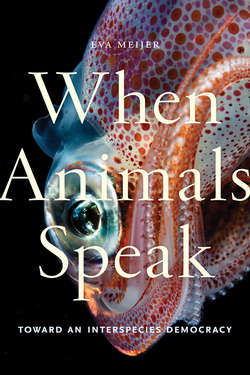Читать книгу When Animals Speak - Eva Meijer - Страница 8
На сайте Литреса книга снята с продажи.
Introduction
ОглавлениеOrangutan Ken Allen was born in the San Diego Zoo. While still in the nursery he was already trying to unscrew every nut he could get his hands on, and he used humans as objects to climb on in order to escape the room. In the years that followed, he perfected his techniques, which led him to escape his enclosure many times. This forced the zoo to alter the fences around the orangutan enclosure and change their windows and locks. They also tried to distract him by bringing in females, and they hired spies posing as visitors in an attempt to find out how he did it. But Ken Allen was not the only orangutan who had a desire to leave captivity. His mate Vicki once took over from him, unbolting a door after he was caught, and escaped. Kumang and Sara, two sisters from the same group, organized and coordinated their own escapes, for example, by using a mop handle that one of them held in place while the other climbed it. Cooperative orangutan resistance is found in many other zoos as well, including in the Woodland Park Zoo in Seattle, where a group of five orangutans slipped through several security doors and climbed over a high wall. Neither bananas nor water from fire hoses could convince them to go back in, and they had to be tranquilized. These examples are not the only ones available—orangutan resistance is a structural problem for zoos, often leading them to isolate individuals or break up family bonds by relocating orangutans (Hribal 2012).
There are many other examples of non-human animals who challenge their oppression (chapter 7): non-human animal workers refuse to work, captive wild animals use violence against their captors, farm animals escape on their way to slaughterhouses, laboratory animals turn their heads away. Other non-human animals seek out human company, either becoming members of human households or taking up residence in their gardens, cities, or fields. Non-human animals may also care for humans or work side by side with them; human and non-human animals can have meaningful encounters, develop friendships, or simply co-exist as neighbors.
Non-human animals are individuals with their own perspectives on life, who form relations with human and non-human others. In current human legal and political systems, and in many cultural practices, they are seen and used as objects. Animal rights theorists have challenged this since the 1970s, arguing that non-human animals are sentient beings, who are similar to humans in morally relevant aspects and who should therefore be seen as part of our moral communities. Drawing on these views, and on insights provided by social justice movements that focus on democratic inclusion, recent work in political philosophy proposes to view non-human animals as political groups, and some of these as members of shared interspecies communities. This movement from ethical consideration to political participation shifts questions about non-human animals from how they should be treated to how more insight can be gained into the ways they want to live their lives, what types of relationships they desire with one another and with humans, and how we can and should share the planet that we all live on (Donaldson and Kymlicka 2011).1
Questions about non-human animal political participation, interspecies communication, and political voice have not received much attention in animal philosophy until now.2 This is unfortunate. Because other animals are subjects with their own perspectives on life, it is not sufficient, either epistemologically or normatively, just to consider them: humans need to reformulate political and social relations in interaction with them in order not to repeat anthropocentrism (see also Donaldson forthcoming). Language plays an important role in thinking about creating better relations with other animals. Learning about the languages of other animals can help humans to understand them better and build new relations with them.3 Challenging an anthropocentric view of language formed by power relations can help humans to see animals of other species, and their languages, differently. Conceptualizing animal languages can also be significant in addressing certain practical problems between humans and other animals, for example, in border conflicts between groups of wild animals and human groups, or with regard to political participation of those non-human animals who are part of our societies. In this book, I discuss these and other questions concerning language and world, politics and activism, shared and sovereign communities, democracy and difference, in order to develop a theory of political animal voices.
